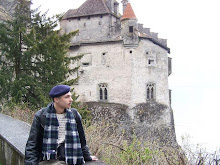..wherein resides an impressive collection of medieval art. There, I had the chance to see - quite possibly - more wood-and-polychrome Madonnas With Child than I would ever expect to find under one roof.
Fortunately for me (as, let's face it, M.W.C.s are not really my medieval cup o' tea) there were some pieces of art that had purses in them! Good thing I brought my little notebook. I wish that photography was allowed (even though I don't have my camera, I could steal someone else's next time.. but it's a moot point) so I could share some pictures, but alas. At the very least, I'll try to make some drawings based on my notes and in-museum sketches, but don't hold your breath.
First off, a nice clear example of a ring-frame purse in the Entombment (
Kladení Krista do hrobu) scene of the
Třeboň Altarpiece (
Oltář třeboňský) by [surprise!] the Master of the Třeboň Altarpiece (
Mistr Třeboňského oltáře), dated at around 1380-1385. The purse is worn by one of two men who are lowering Christ's body into the tomb, while the Virgin Mary, Mary Magdalene(?), and a few other haloed persons* watch. It's undecorated, and I can only assume that it would've been executed in leather. What drew me to it was the way it's attached to the man's belt (even though I can't really see a belt at all.. there's a fold in his tunic, I'll have to assume he's got a belt under there somewhere). Around a tertiary loop on the frame** is wound a small leather strap, complete with buckle. The strap also shows a few extra belt holes as well. Why? Is the ability to adjust your purse by a few centimeters closer or further from your midsection all that necessary? Could it be that the gentleman in question had only a leftover bit of belt/garter/etc strap to which he could fasten purse to belt, or was the strap "part" of the purse itself? I have no idea; all I know is I haven't yet seen many extant examples of fastening devices included with the purse.
In another painted panel, the Visitation (
Navštívení Panny Marie) scene of the
St James Altarpiece (
Oltář svatojakubský) by the workshop of the Master of the Rajhrad Altarpiece (
Mistr Rajhradského oltáře), dated around 1430, St Elizabeth is wearing a purse very similar in design to this French purse:
LACMA obj. M.91.165. St Elizabeth's, however, has a main knopf/tassle on the base of the purse, and one on each of the two drawstrings (does that French purse have 3 drawstrings??). Also, I noticed that there was some sort of donut-shaped bead right about the opening. I was curious as to whether or not that was some sort of slider to help keep the purse closed (as if gravity weren't enough) or to keep prying fingers out (as if they couldn't simply cut the suspension loop and run off with the whole thing.. see Goubitz's
Purses in Pieces). It could be something akin to the 'ears' seen on the French one (to aid in opening), but I'm not convinced. I'm not actually convinced that both those knopfs on the French purse are 'ears'.. there's something going on in the one in the background.
There were two more, but this post is getting a wee bit long, and believe it or not, I actually have some work to do :-( I'll discuss the other ones later, and hopefully have some sketches at some point too!
*OK, I have the details somewhere, just not with me at the moment. It's besides the point anyhow.
**I promise a diagram!



